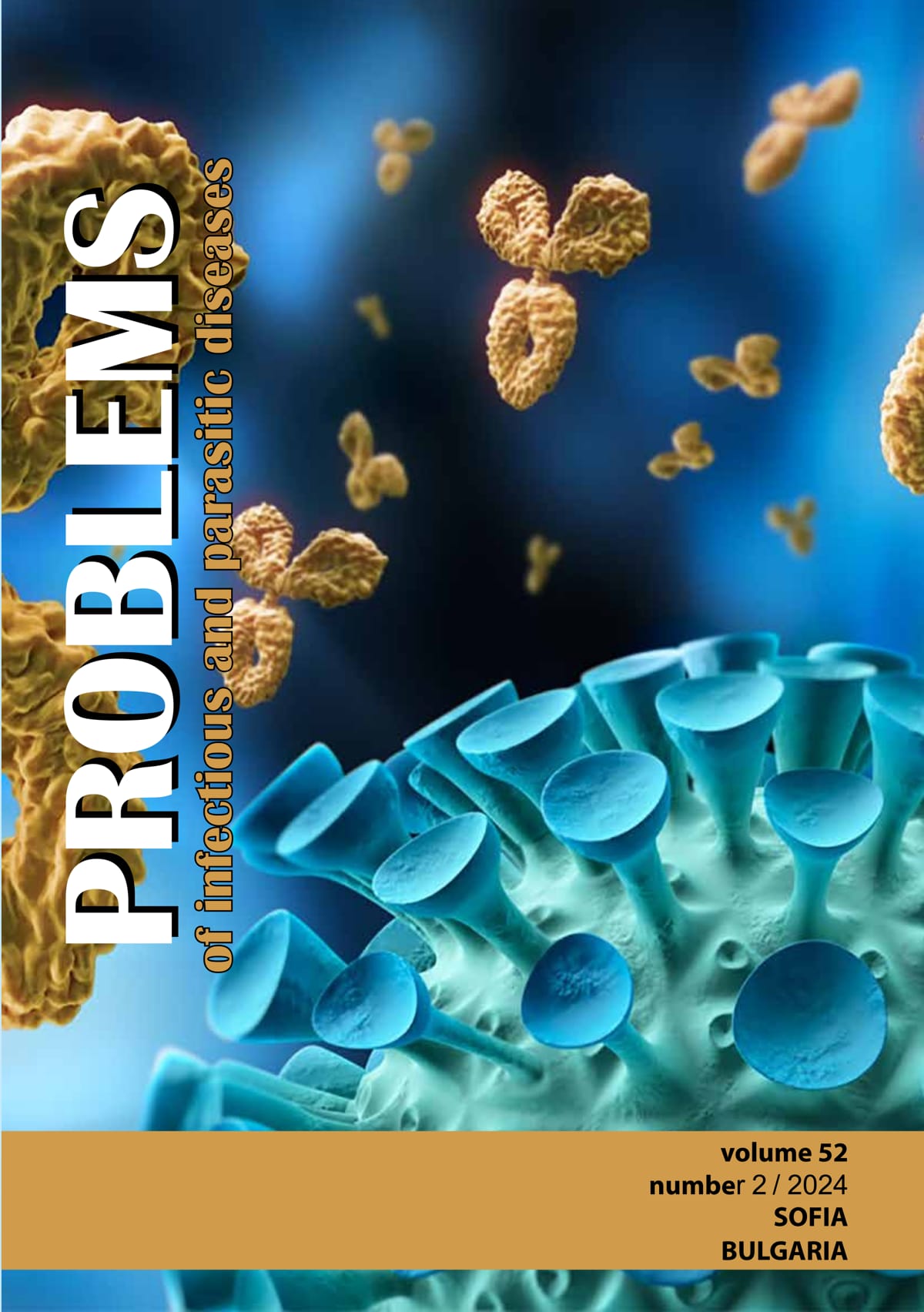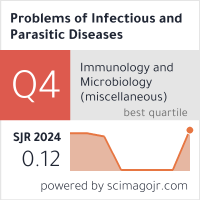KLEBSIELLA PNEUMONIAE – CAUSATIVE AGENT OF ENTEROCOLITIS.
A brief literature review.
DOI:
https://doi.org/10.58395/0ch67n63Abstract
Gastrointestinal diseases have one of the highest incidence rates worldwide. Klebsiella spp., which is a part of the large family Enterobacterales, isolated from fecal samples is considered as a part of the normal intestinal flora, even when it presents as a monoculture. The transmission of virulent plasmids from E. coli strains to Klebsiella spp., raises the question whether those bacteria can be an etiological factor for severe diarrhoea. By using PCR methods, the lth gene which is coding heat-labile enterotoxin (LT) was presented in the plasmids of Klebsiella spp. strains, and its expression was assessed.by measuring the cytopathic effect induced by the LT toxin.
Downloads
References
1. Jondle CN, Gupta K, Mishra BB, Sharma J. Klebsiella pneumoniae infection of murine neutrophils impairs their efferocytic clearance by modulating cell death machinery. PLoS Pathog. 2018 Oct;14(10):e1007338. https://doi.org/10.1371/journal.ppat.1007338
2. Rodrigues C., Passet V., Rakotondrasoa A., Brisse S. (2018). Identification of Klebsiella pneumoniae, Klebsiella quasipneumoniae, Klebsiella variicola and Related Phylogroups by MALDI-TOF Mass Spectrometry. Front. Microbiol. 9:3000. https://doi.org/10.3389/fmicb.2018.03000
3. Rodrigues C., Passet V., Rakotondrasoa A., Diallo T. A., Criscuolo A., Brisse S. (2019). Description of Klebsiella africanensis sp. nov., Klebsiella variicola subsp. tropicalensis subsp. nov. and Klebsiella variicola subsp. variicola subsp. nov. Res. Microbiol. 170 165-170. https://doi.org/10.1016/j.resmic.2019.02.003
4. Lai YC, Lin AC, Chiang MK et al. Genotoxic Klebsiella pneumoniae in Taiwan. PLoS One 2014; 9: e96292. https://doi.org/10.1371/journal.pone.0096292
5. Klipstein F.A., Engert R.F., Enterotoxigenic intestinal bacteria in tropical sprue. III. Preeliminary characterization of Klebsiella pneumoniae enterotoxin, J. Infect. Dis., 1975, 132, 200-203. https://doi.org/10.1093/infdis/132.2.200
6. Klipstein F.A., Horowitz I.R., Engert R.F., Schenk E.A., Effect of Klebsiella pneumoniae enterotoxin on intestinal transport in the rat, J. Clin. Invest., 1975, 56, 799-807. https://doi.org/10.1172/JCI108158
7. Klipstein F.A., Engert R., Purification and properties of Klebsiella pneumoniae heat-stable enterotoxin, Infect. Immun., 1976, 13, 373-381. https://doi.org/10.1128/iai.13.2.373-381.1976
8. Klipstein F.A., Engert R.F., Houghten R.A., Immunological properties of purified Klebsiella pneumoniae heat-stabile enterotoxin, Infect. Immun., 1983, 42, 838-841. https://doi.org/10.1128/iai.42.2.838-841.1983
9. Martin R. M., Cao J., Brisse S., Passet V., Wu W., Zhao L., et al. (2016). Molecular epidemiology of colonizing and infecting isolates of Klebsiella pneumoniae. mSphere 1:e0261-16. https://doi.org/10.1128/mSphere.00261-16
10. Gorrie C. L., Mirceta M., Wick R. R., Edwards D. J., Thomson N. R., Strugnell R. A., et al. (2017). Gastrointestinal carriage is a major reservoir of Klebsiella pneumoniae infection in intensive care patients. Clin. Infect. Dis. 65 208-215. https://doi.org/10.1093/cid/cix270
11. Chung H, Pamp SJ, Hill JA, Surana NK, Edelman SM, Troy EB, Reading NC, Villablanca EJ, Wang S, Mora JR, Umesaki Y, Mathis D, Benoist C, Relman DA, Kasper DL. Gut immune maturation depends on colonization with a host-specific microbiota. Cell. 2012 Jun 22;149(7):1578-93. https://doi.org/10.1016/j.cell.2012.04.037. PMID: 22726443; PMCID: PMC3442780.
12. Anderson D. J., Richet H., Chen L. F., Spelman D. W., Hung Y.-J., Juang A. T., et al. (2008). Seasonal variation in Klebsiella pneumoniae bloodstream infection on 4 continents. J. Infect. Dis. 197 752-756. https://doi.org/10.1086/527486
13. Russo T. A., Marr C. M. (2019). Hypervirulent Klebsiella pneumoniae. Clin. Microbiol. Rev. 32:e00001-19. https://doi.org/10.1128/CMR.00001-19
14. Krewulak KD, Vogel HJ. Structural biology of bacterial iron uptake. Biochim Biophys Acta 2008; 1778: 1781-804. https://doi.org/10.1016/j.bbamem.2007.07.026
15. Cherayil BJ. The role of iron in the immune response to bacterial infection. Immunol Res 2011; 50: 1-9.Chung et al., 2012. https://doi.org/10.1007/s12026-010-8199-1
16. Martínez JL, Delgado-Iribarren A, Baquero F. Mechanisms of iron acquisition and bacterial virulence. FEMS Microbiol Rev 1990; 6: 45-56. https://doi.org/10.1016/0378-1097(90)90522-R
17. Holden VI, Lenio S, Kuick R, Ramakrishnan SK, Shah YM, Bachman MA.Infect Immun. 2014 Sep;82(9):3826-36. https://doi.org/10.1128/IAI.01849-14
18. Merino S, Camprubí S, Albertí S, Benedí VJ, Tomás JM. Mechanisms of Klebsiella pneumoniae resistance to complement-mediated killing. Infect Immun 1992; 60:2529-35. https://doi.org/10.1128/iai.60.6.2529-2535.1992
19. Cuevas-Ramos G, et al. Escherichia coli induces DNA damage in vivo and triggers genomic instability in mammalian cells. Proc. Natl Acad. Sci. USA. 2010;107:11537-11542. https://doi.org/10.1073/pnas.1001261107
20. Coppé J.P., Desprez P.Y., Krtolica A., Campisi J. The senescence-associated secretory phenotype: The dark side of tumor suppression. Annu. Rev. Pathol. 2010;5:99-118. https://doi.org/10.1146/annurev-pathol-121808-102144
21. Cano V, March C, Insua JL, Aguiló N, Llobet E, Moranta D, et al. Klebsiella pneumoniae survives within macrophages by avoiding delivery to lysosomes. Cell Microbiol. 2015 Nov;17((11)):1537-60. https://doi.org/10.1111/cmi.12466
22. Lee IA, Kim DH. Klebsiella pneumoniae increases the risk of inflammation and colitis in a murine model of intestinal bowel disease. Scand J Gastroenterol 2011; 46: 684-93. https://doi.org/10.3109/00365521.2011.560678
23. Zhou W, Cao Q, Peng Y et al. FoxO4 inhibits NF-κB andprotects mice against colonic injury and inflammation. Gastroenterology 2009; 137: 1403-14. https://doi.org/10.1053/j.gastro.2009.06.049
24. Karin M, Ben-Neriah Y. Phosphorylation meets ubiquitination: the control of NF-[kappa]B activity. Annu Rev Immunol. 2000;18:621-63. https://doi.org/10.1146/annurev.immunol.18.1.621. PMID: 10837071.
25. Wen LL, Chiu CT, Huang YN, Chang CF, Wang JY. Rapid gliaexpression and release of proinflammatory cytokines inexperimental Klebsiella pneumoniae meningoencephalitis. ExpNeurol 2007; 205: 270-8. https://doi.org/10.1016/j.expneurol.2007.02.011
26. Behzadi P, Behzadi E, Ranjbar R. Autoimmunity, Crohn's disease and anti-Saccharomyces cerevisiase autoantibodies, farmacistro.2014; 156(1);50-52.
27. Economou M, Zambeli E, Michopoulos S. Incidence andprevalence of Crohn's disease and its etiological influences. ANNALS OF GASTROENTEROLOGY 2009, 22(3):158-167
28. Pavlova M., Velev V., et al., Clinically significant Escherichia coli. Diagnosis and prevalence in Bulgaria. Bulgari Publishers, Sofia, 2022. ISBN 978-619-7656-25-1.
29. Berberov E.M., Zhou Y., Francis D.H., Scott M.A., KachmanS.D., Moxley R.A., Relative importance of heat-labile enterotoxin in the causation of severe diarrheal disease in the gnotobiotic piglet model by a strain of enterotoxigenic Escherichia coli that produces multiple enterotoxins, Infect. Immun., 2004, 72, 3914-3924. https://doi.org/10.1128/IAI.72.7.3914-3924.2004
30. Alessio M., Albano F., Tarallo L., Guarino A., Interspecific plasmid transfer and modification of heat-stable enterotoxin expression by Klebsiella pneumoniae from infants with diarrhea, Pediatr. Res., 1993, 33, 205-208. https://doi.org/10.1203/00006450-199302000-00023
31. Guarino A., Capano G., Malamisura B., Alessio M., Guandalini S., Rubino A., Production of Escherichia coli STa-like heat-stable enterotoxin by Citrobacter freundii isolated from humans, J. Clin. Microbiol., 1987, 25, 110-114; https://doi.org/10.1128/jcm.25.1.110-114.1987
32. Nair G.B., Takeda Y., The heat-stable enterotoxins, Microb. Pathog., 1998, 24, 123-131; https://doi.org/10.1006/mpat.1997.0177
33. Pobucewicz A., Czernomysy-Furowicz D., Characteristics of Citrobacter freundii strain with special focus on its ability to produce toxins [Charakterystyka Citrobacter freundii, ze szczególnym uwzględnieniem ich zdolności do wytwarzania toksyn], Post. Mikrobiol., 2010, 40, 43-46, (in Polish)
34. Mavzioutov A., Bondarenko V., Baymiev A.N., Baymiev A., Escherichia enterotoxins genes are detectable among clinical isolates of Klebsiella ssp. and Proteus spp., Clin. Microbiol. Infect., 2002, 8, Suppl.1, Abstract P614
35. Popov M., Evtimova E., Manolov H.,Bacterial enteric infections with isolate K. oxytoca. Incidence, clinical characteristics and therapeutic approach. MedInfo. Number 08/2017, Year XVII
Downloads
Published
Issue
Section
License
Copyright (c) 2024 Rositsa Stoyanova (Author)

This work is licensed under a Creative Commons Attribution 4.0 International License.






